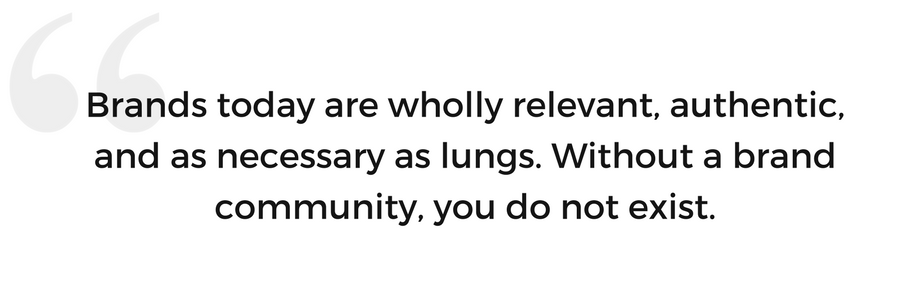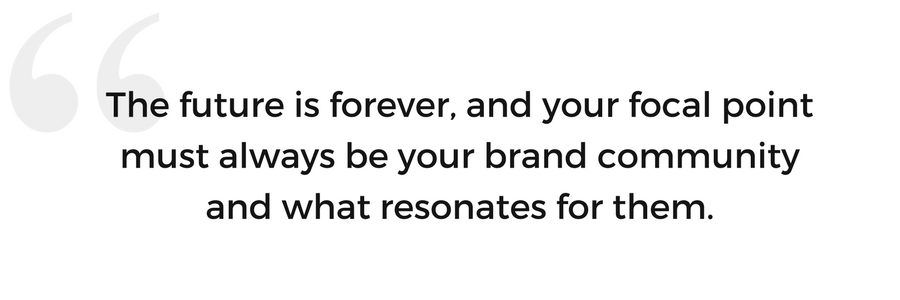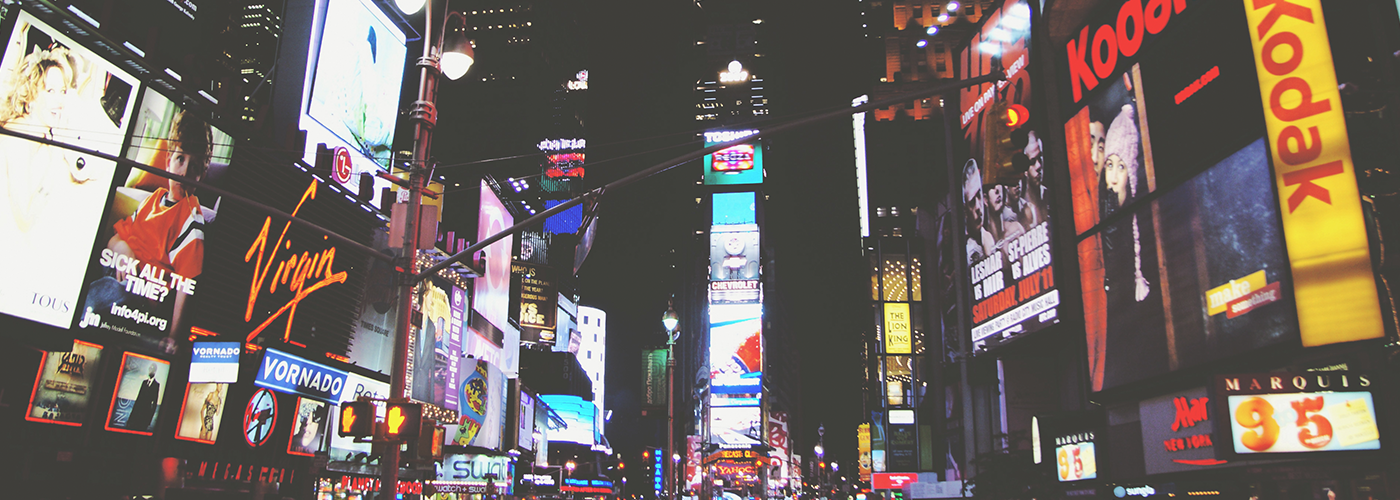Quick question. Is it better for your brand to have one million views (hits) on YouTube or one million minutes viewed?
Let’s answer this right away. It’s better to have one million viewed minutes. Why? Because on YouTube, it’s not how many people watched, but how long people watched—minutes viewed is the meaningful for your brand’s content.
This is what matters.
Increasing your user’s time with your Brand is today’s marketing challenge. You can’t reach them on network television, but you can float alongside as they stream through the friendly waters of Instagram, tweets, selfies, Snapchat, Facebook and whatever.
If you don’t, the serious answer to the question in the headline above is that, no you probably aren’t going to make it to 2020.
The simple fact is that many brands just don’t connect with today’s consumer. Tweet This Quote
The simple fact is that many brands just don’t connect with today’s consumer.
Legendary companies are calling it quits, while others are experiencing an era of the slow death. After shedding acres of real estate, Sears finally sold off its legendary Craftsman tool brand to competitor Stanley Black & Decker for $900 million. Macy’s is shutting 60 stores and cutting over ten thousand jobs. J.C. Penney announced it will close 140 stores. Toys ‘R’ Us just laid off 250 employees at corporate. The Limited has shuttered its stores. American Apparel, OfficeMax, PacSun, BlackBerry, Nokia, Best Buy, BCBG, Abercrombie & Fitch, J. Crew, Gymboree, Payless, Claire’s, True Religion and even socially conscious TOMS Shoes are all slated for bankruptcy, debt restructuring or other upheaval in 2017.
Other brands are becoming hollow shells of what they once were, as their line extensions are nibbled to death by agile, more relevant newcomers. Look at the soda aisle, the snack aisle, the cereal aisle, the watch counter: companies are no longer beset by a dominant primary competitor but by a raging multitude of smaller rivals playing with new rules.
So, okay. Some brands will not make it to 2020—according to a recent survey, 19 percent of retailers have no digital transformation strategy at all. But other brands will adapt, be adept, pivot and hack their way toward the future.
How to Survive
The main question is not about clicks, attribution, or fear of missing out on the next-ness of everything. Instead, it’s about how to distribute your product message across whatever channels are relevant to you so that users, consumers, and fans feel the one-to-oneness that helps them feel that they are a part of your brand community.
Understand, first and foremost, that ‘digital first’ and ‘conventional’ marketing may be at odds, but they need not be mutually exclusive.
Digital first is terrific because you can drive awareness and advocacy without needing a budget of millions of dollars. It just requires more work.
 Conventional or traditional marketing—running television commercials and print ads—requires millions of dollars and is not as believable or as effective as it once was. (And the right traditional advertising is still able to jumpstart or maintain high profile awareness.)
Conventional or traditional marketing—running television commercials and print ads—requires millions of dollars and is not as believable or as effective as it once was. (And the right traditional advertising is still able to jumpstart or maintain high profile awareness.)
Neither digital first or traditional marketing are totally right or totally wrong. The advantage is to understand how use them as tools to remain relevant and help users feel not that you build products, but that you are building community.
Brand is Community
If you still look at your company, product, or service as your “Brand,” then you’re off track. If you look at “Brand” as something abhorrent and to be avoided, then you’re also off track.
Help users feel not that you build products, but that you are building community. Tweet This Quote
Your “Brand,” these days, is the community of people that sustains you, advocates for you, talks about you and consumes you. Yes, that means they buy you and (this bears repeating) they buy into you. Users, consumers, people who “Like” you are your Brand. “Brands” today are wholly relevant, authentic, and as necessary as lungs. Without a brand community, you do not exist.
What has changed is that, after decades of being told what to think about your product via millions of dollars in advertising spend, consumers no longer care. What consumers really care about is what other consumers have to say about you. Tattoo that somewhere on your body.
The New Survival KPIs
Your new key performance metrics should be laid out roughly against these criteria (this is growth hacking):
User acquisition – Getting new customers is your key to growth.
Retention – Keeping those new customers, keeping them happy, and possibly even turning them into zealots and heavy users, advocates or influencers is a potential goal.
Churn – No matter how excellent your product or service may be, not everyone is going to like you. Lots of people would rather drink Dunkin’ Donuts than Starbucks and vice versa. Your reason for being (as product manager) is to find out why they leave you. Not the Simon Sinek “Why?” Instead, there may be something truly wrong with your product. There might be a quality issue, a pricing issue, a sizing issue, customer service issue or some other operational issue that you need to know about.
Resurrection – You also need to know if it’s possible to bring those people back. And, if so, how to keep them happy members of your brand community the second time around.
One more metric that is important, is how many purchases it takes to create “heavy users” in your ecosystem. Example: Facebook knows that if you ‘friend’ just seven people, you will be coming back to Facebook.
With some consumer packaged goods products, if you buy a product three times, you’ll generally buy it again and again. For some products, it’s five times. Or seven times. Find your metric.
Think Old, Think New
One irony in today’s marketing is that some of the newest traits in consumer marketing these days are appropriated from traditional B2B models. Twenty-first century sales funnels today reek of 1970s direct marketing tactics, a demonstration of just how far we have (or haven’t) come.
Example. “User reviews” are nothing more than “testimonials”: a traditional staple in B2B human-to-human marketing efforts. These days, user reviews are requisite must-haves and most products and services cannot exist without them.
The paradox is that traditional media (i.e. the 30-second television spot) remains the safe comfort zone for conventional marketers. Marketers still spend millions over millions communicating to users who really don’t care (or believe) what they have to say.
So many advertisers’ last resort is to entertain consumers, make them laugh and render a mood or tone rather than the rigor of feature/benefit advertising. And they spend $3-6-12 or $30 million dollars for the effort.
 For new products, traditional advertising is an awareness accelerator. If you create great content, you’ll also get tens of thousands of replays on YouTube.
For new products, traditional advertising is an awareness accelerator. If you create great content, you’ll also get tens of thousands of replays on YouTube.
Today, Users (nee consumers) are persuaded by peer-to-peer social media that culminates in word of mouth (WOM)—someone liking you, using you, talking about you.
Your users do the marketing for you, but it’s a slower process. Social requires legions of screeners, analysts, real-time hand-holding and a vigilant CMO who serves as master conductor, continually surveying what is working—and what is not—in real time.
This flies smack in the face of conventional CMOs who need to be in a meeting talking about marketing rather than practicing it. And that is where traction is lost.
Depending on your category and business size, you could give up $20,000 or $1 million in a single day of online retailing because you missed pulling a single lever.
In the culture of online immediacy, actions are more productive than meetings.
Brilliant Ideas Serve Brilliant Brands
The most valuable position for advertising agencies today is their ability to produce great content, pure and simple.
MailChimp, a long-standing resource for email campaigns, has combatted ConstantContact, Emma and other rivals for years, each marketer clenching the other in a sort of wrestling sleeper hold.
MailChimp has been the first to break through with a new campaign from Droga5 (named best agency of 2016) in a daring campaign that advertises word pairings that sound like—or might be confused by—those nifty two syllables “MailChimp”.
The campaign boldly advertised mystery products named “Snail Primp,” “Kale Limp,” and “Jail Blimp,” and invited prospects to sites for three interactive films. The short films ran in theaters and on YouTube and have received tens of thousands of views.
Marketers still spend millions over millions communicating to users who really don’t care (or believe) what they have to say. Tweet This Quote
(I almost bought a package of the stunt campaign’s “Fail Chips” at an airport, until I realized that the chips failed because they were pre-crushed. I crush my own chips.)
“Snail Primp,” “WhaleSynth” and “Mail Champ” were other sound-alike names in the Mail Chimp campaign, which reminds us that there are no boring products (or boring email programs), only boring ads. Hail Mail Chimp for not relying on some unremarkable B2B campaign, and instead owning the category.
Another example of creative-first is the first brand push from The Honest Company. The Jessica Alba-backed brand recently suffered product quality issues, so the brand needed to remind young mothers of the company’s reason for being.
Birth is the ur-mythic creation story for each of us and that’s where The Honest Company shines the spotlight, reminding us all of what is true and real. Kudos to The Honest Company brand stewards, for reminding us why they exist without becoming a lame Kodak moment.
But if agencies think they can lean back and give themselves a round of attaboys for their role as content providers, think again. This article was originally posted Monday. Today is Thursday. In the intervening three days, Coke brand has announced it will use AI bots to create messaging. And a unique new AI visualization tool has been announced that can spin 25 different stories from a single set of data. Those stories (ultimately, see below) could be matched against individual user profiles derived from Facebook “likes” so they are customized one-to-one not to psychographics but to individuals.
Since artificial intelligence can learn X-times faster than humans, the future will hit advertising agencies faster than an asteroid. Agencies can start rubbing their Cannes Gold Lions for luck.
Mobile – Not Just Another Media Outlet
Mobile has become the focal hub of the marcomm omnichannel matrix. Today, smartphones are at the hub of our actions, Likes, desires and preferences. As revealed in a recent article, Cambridge Analytics in England can take Facebook data and know us better than friends, colleagues, spouse and family. From just ten “Likes”, Cambridge Analytics can extrapolate your personality and know you better than co-workers. From 300 “Likes” they claim to know you better than your spouse.
More. They can use this information to target Brand communications-messaging specific to your profiled wants and needs. Perhaps nobody feels better after looking at Facebook, but Life can be beautiful within the distortion field of the self-reinforcing bubble. No matter where you intend to socialize your product or service, you must be in mobile.
In the face of trends like personalization, the end of apps, Internet Of Things, and augmented reality, nothing will be as important as your proficiency on mobile devices. Think of mobile as your safety net: If you are in mobile, your Brand exists.
That doesn’t mean you need to build an App. Borrowing facts spread across the Internet, smartphone users spend 84 percent of their time in just five apps, that 80 percent of apps never make it to 1,000 downloads, that 84 percent of consumers that download an app will delete it after only one use, and that when brands run ad campaigns to download their apps, they experience up to 95 percent abandonment.
Your users live eight days a week, and you should too. Tweet This Quote
No one knows what the next new thing will be, although it is likely to be some intersection of artificial intelligence, machine learning, personalization. With maybe a hint of augmented reality.
Plenty of people may want to jump in right here, but the sad hammer of truth is that nobody really knows. As Silicon Valley investor Keval Desai reminds us, “Success is about finding consumer daily habits that are reimagined using new breakthrough technology.”
The future is forever, and your focal point must always be your Brand community and what resonates for them and you: the reason for being that attracts you and draws you together, what you celebrate.
Hashtags, pins, likes and attendance are the rites of belonging. When those rites are embedded with other engagements—including purchase—your fans become more connected to your strategic narrative. All of which makes your community more relevant, resonant, noteworthy and powerful.
If you’re not thinking like this already, you may have to radically shift your thinking and activities. “But I would have to reconfigure my operations and probably lose 30 percent of my workforce,” declared one global company CEO, off the record.
Yes. But is it better to slide gently down the demand curve and lose the whole enterprise?
Remember. As users, your consumers are media omnivores. So your brand community expects to be surrounded eight days a week by a full omnichannel spectrum of relevant media interactions that might include any (or all) of the following (depending what industry sector you occupy): live experiences, outdoor (OOH), social media interactions, digital, traditional advertising when appropriate, user reviews, articles by bloggers, Influencers, email campaigns, in-store, advocacy programs, and via public relations efforts, not to mention virtual reality, the new artificial intelligence (AI) social engines, instant Apps, and social advocacy platforms like Facebook, Instagram, Pinterest, Twitter.
 One social media expert sorts it out like this, “Facebook is what you’ve done, Instagram is what you’re doing, Pinterest is what you’re planning to do.”
One social media expert sorts it out like this, “Facebook is what you’ve done, Instagram is what you’re doing, Pinterest is what you’re planning to do.”
Let’s suppose that Snapchat and Twitter are captured moments in the “now” (Snapchat would be a catch-and-release moment).
This continual fluffing, pruning and adjusting might seem like micromanagement, meddlesome for managers, but it is full-time collaboration. Your users live eight days a week and you should too. Working together to meld market strategy with market implementation, concept plus execution, is the new brand world.
Sure, Coke still spends $1 billion annually. Paradoxically, Apple’s advertising budget (the most valuable company in the world) is a fraction of that. Go figure. (2016’s global advertising revenue grew to $532 billion, by the way.)
To wrap this up, nobody is right or wrong. Rather, everybody is in danger if they forget that the glory point for building Brand communities is to connect with users rather than talking at them (the point of view that differentiates social media from conventional advertising).
Dare Yourself to Engage
The year 2020 is just around the corner. Survivors will be those who understand that users, fans, advocates, vendors, VCs, influencers, Likes and consumers are your “Brand.” They must be continually welcomed, engaged, fluffed and connected to themselves and to other fans.
Your users don’t just drink the Kool-Aid, they serve it and invite others to stand with you behind the Kool-Aid stand.
When John Wannamaker in Philadelphia famously declared 100 years ago that half of his advertising was wasted, he asked the wrong question. The question is not about which half is being wasted, but what to do with the other half?
This originally published on Forbes.



